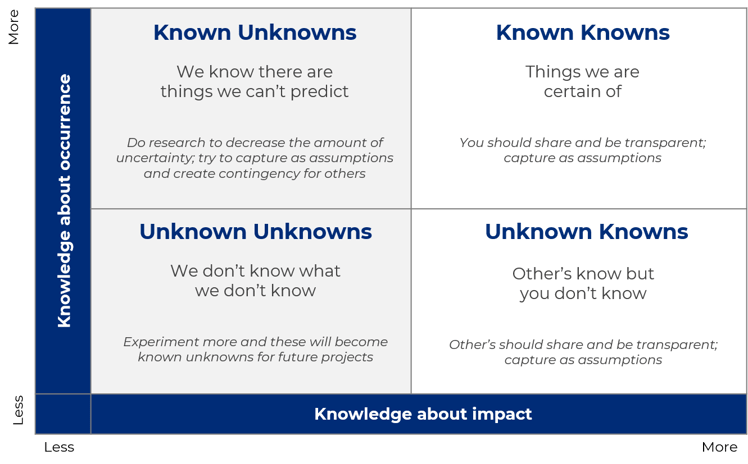A good project manager will do a considerable amount of planning before starting a project. However, no matter how diligent the manager is, there will always be a surprise lurking around the corner especially in a big and complex CTRM project. Surprises can quickly derail a project schedule and plan, making them irrelevant. This is why taking time to identify risks is an important step in managing projects. There are four categories to risks – known knowns, known unknowns, unknown knowns and unknown unknowns. We will focus on unknown unknowns and known unknowns in this article.

Known Unknowns: Risks that we can capture and plan around
Known unknowns are defined as risks that we can anticipate but we are uncertain of the timing or impact. Let’s explore a few examples of known unknowns that we typically experience in a CTRM or Risk Advisory project:
Changes to the business
New strategies, mergers and a shift of priorities can completely shift the focus of the organization. The longer the project, the more likely one of these risks will materialize.
Technology disruptors
Vendors will roll-out updates to systems and impact to current project is unknown.
Market shifts
We know the cost of oil will change, but don’t know what it will be tomorrow.
Geopolitical events
We know political leaders and parties will change, but we don't know when or how the changes they enforce will impact markets.
Loss of key resources
This could be a short time period (e.g. the flu or something more prolonged). Also, we know people will resign, join or go on maternity leave, but not sure who or when.
Acts of God
Hurricanes, floods, blizzards and earthquakes happen, and they impact the project because even if the office is not damaged, project team member’s homes and families will need to be put first.
For the known unknowns, it’s possible to loosely plan for and have alternative plans ready.
Steps to prepare for Known Unknowns:
Document assumptions
Make sure all assumptions made while planning for project are documented and shared across team including the project stakeholders. Transparency is key.
Have a Plan B ready
Come up with alternative solutions and path forward just in case the risk happens. Going through alternative solutions while planning makes it easier for the team to adapt to the change because its already been communicated.
Include contingency
Include contingencies in both project cost and schedules. Adding this to the project plan is good practice to cover the project for a risk or uncertainty.
Unknown Unknown: Managing Unidentified Risks
The project team cannot plan for or manage the unknown unknown risks, but they happen all the time. PMI defines unknown unknowns as events believed to be impossible to find or imagine in advance. However, it is possible to manage and minimize the negative impact once they do surface. So, what steps does a project manager take when unknown unknowns hit a project?
Steps to properly manage Unknown Unknowns:
Understand the root cause of the issue
Sometimes the issues raised seem large and unsolvable, but after further investigation the root cause may be small. Finding the root cause is a productive exercise because understanding the cause can lead to a solution that is more appropriate for the issue. Don’t be afraid to ask questions and get dirty but remember if it’s a people driven cause vs. a system induced cause, don’t play the blame game.
Raise issues early but do so with a plan
When a risk becomes a reality, the project manager is responsible for communicating early but he should also be ready to answer hard questions about impact to the project. Present a recommended solution so that stakeholders can be assured that the project can move forward. It would also be helpful if the solution being recommended has been seen and has been blessed by key stakeholders.
Keep the team updated on the progress
Having a regular communication plan and pattern is key to establish trust and credibility. When issues come up, the need to communicate and reach out to the entire team becomes even more critical. The message may not be the same level for everyone, but it is good practice to be open and honest about what the project team is facing. Building a culture of trust, teamwork and integrity in the project team is key because a high performing team will come together and try to resolve the issue. Culture is so important that we have created our very own culture code at Veritas. It makes sure that we all have the same priorities and values through good and bad times.
Flag the issue as a Known Unknown for future projects
Documenting the experience and solution helps future projects avoid the risk that was just encountered. The risk is now better understood and should be documented as a known risk for other projects.
The challenge for the project manager is to turn as many unknown unknowns into known knowns so the project team can prepare. Of course, not all possibilities can be thought of and planned, but there are ways to minimize delays and negative impact to the project caused by unknown unknowns. The biggest takeaway is to become better equipped at identifying, predicting and managing the risks related to these occurrences when building the project plan.
This blog is part of the CTRM Project Management Done Right series. Check out our other blogs in the series.
- CTRM Project Management Done Right
- Measure Twice, Cut Once: Planning for a Successful Project
- Expectation Management: The Difference Between Project Success and Failure
- Embedded Change Management: How to be a Change Manager without Telling Anyone
- Stabilization: 4 Tips to Increase User Adoption for CTRM Projects
- Optimizing Post Go-Live: 5 Tips to Ensure Delivery of Business Value
At Veritas Total Solutions, we are experts in CTRM Systems and believe our unmatched ability to mitigate and manage risk on a project makes us uniquely positioned to help you reach business value. If you are interested in learning more about our specific capabilities, contact us to learn more or subscribe to our blog to stay connected.

